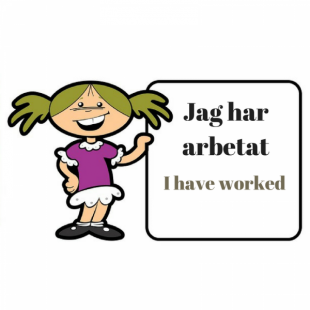Swedish past tense
Sign up for free to get all information about private lessons and our available group courses (A1, A2, B2, B2, C1, C2)
Sign up for freeSign up for free to get all information about private lessons and our available group courses (A1, A2, B2, B2, C1, C2)
Sign up for freeHej! Today we will have a look on how to construct past sentences which are useful when expressing ourselves regarding events who have already happened. Whilst speaking Swedish you will often have to use the past tense, therefore it is important that you know how everything works!
The past tense is pretty simple and is employed the same way as the English language. It consists of the present tense and their supine form. You get the past tense by using the imperfect form instead of the present tense. The imperfect form is created by adding a suffix to the stem. Confusing? Don't worry this lesson will make you understand the past tense very quickly.
There are two tenses which express the past in Swedish. The past simple and present perfect, "Preteritum" and "Perfekt".
We distinguish five groups of verbs which follows;
Group I, Group II a, Group II b , Group III , Group IV ( irregular verbs).
Group I - most of the Swedish verbs belong to this group
Group II - vers that end with -s, -p, -t and -k.
Group III - those are short verbs that end with vowels, ie; bo, tro , må
Group IV - irregular verbs
Note! each form of the verb depends on the group that a verb belongs to.
Have a look at the following sentences;
Look at the table below in order to see how the verbs are constructed.
Infinitif | Past | Ending | Meaning | Group |
| prata , träna | pratade , tränade | -ade | talk , train | Group I |
| ringa, glömma | ringde, glömde | -de | call , forget | Group II |
| läsa, köpa | läste , köpte | - te | read (learn) , buy | Group II b |
| bo, tro | bodde , trodde | - dde | live (occupy) , believe | Group III |
| komma , skriva | kom , skrev | några olika | go, write | Group IV |
Have a go at writing your own sentences and use the table as guideline if your are unsure.
In order to create the imperfect tense you add 'de' to the stem, however it will not be added if the stem ends with a voiceless consonant i.e: (f, k, p, s, t etc.) that's when you attach 'te'.
In regards to the supine (indifferent), it is formed by attaching 't' to the stem.
As this group consists of many irregular verbs, In the imperfect tense most Swedish verbs don't have a suffix. They simply just change the stem-vowel. In the supine, most verbs change the stem-vowel again and add 'ít' or 'at' at the end. Have a look at the table below for for examples.
Verbs | Stem | Imperfect | Supine | Perfect | Past perfect |
| tala (speak) | tala- | talade | talat | har talat | hade talat |
| ringa (call) | ring- | ringde | ringt | har ringt | hade ringt |
| springa (to run) | spring- | sprang | sprungit | har sprungit | hade sprungit |
| ha (have) | ha- | hade | haft | har haft | hade haft |
| äta (eat) | ät- | åt | ätit | har ätit | hade ätit |
Rememer:
This tense is used to express something which has already happened and that has an influence on the present.
We hope you have enjoyed the lesson and have learnt on how to use and construct sentences using the past tense. Now have a look below at the short video on Swedish past tense. Why not go and have a look at the rest of the Swedish online course. See you soon!